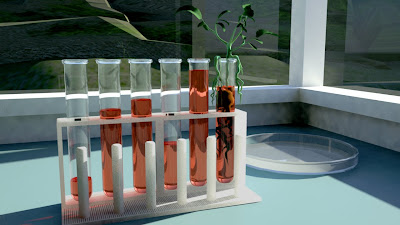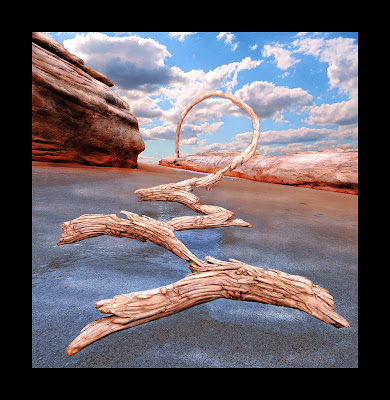Another day, another post.
The three pieces in this series were part of my Photoshop 2 class that I took in Spring 2009 at Lake Washington Technical College (LWTC). If you've paid attention to the math, you might realize that I took Photoshop 3 BEFORE Photoshop 2. I was given permission since I had TA'ed in my Photoshop 1 class a couple years back. Plus, it helped that the teacher knew me and knew that I enjoyed the challenge. Like my previous post and the last time I took a Photoshop class, the teacher was Bobbi Julag-Ay.
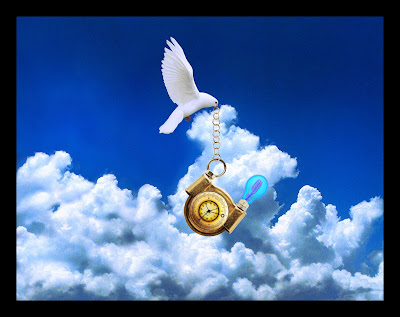
First I created the "ClockStop" from a mixture of a Stop Watch, Water Guage, Vice, and Lightbulb. After making the proper adjustments and image tweaks I then created the scene.
The clouds and sky were initially one image, perhaps a quarter of the size of the whole. I used the Clone Stamp and built up the clouds to give full image coverage. Next I brought in the dove and created the chain from the torus that was left over from the Stop Watch. After compiling the pieces I went through and made global enviromental adjustments such as lighting correction and proper levels adjustments to give the image the completed look you see above. I was aiming for a surreal and peaceful mood, which I why i enchanced the blues in the scene and kept the upper part of the sky clear; trying to latch on to and use the negative space to enchance the richness and purity of a clear sky.
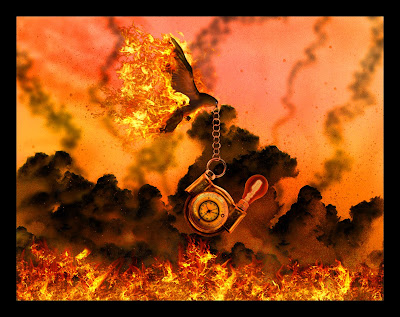
This next image seems to be the one that most people like the most. Which is good, because I like it also. I wanted the image to be a polar opposite of the previous. So instead of peaceful and clear, I set it on fire! A good refreshing tactic when you're running low on ideas for a series.
I started by inverting the coloring of the dove, lightbulb, and clouds; then I went to go shop around. Where I see most people make final adjustments, assuming that an inverted color is enough, I used the Select Color Range and made my adjustments one screwed up looking level at a time with the usual suspects: Levels, Color Balance, and a cocktail of Adjustment Layers with all sorts of fun Layer Modes. After getting the coloring to a stage that I felt good about, I went crazy with the fire. Fire is difficult to place in a scene. I thought about bringing in some extra heat by lighting the base of many of the flames with plasma (as represented by the bluish/purple coloring you get near extremely hot sources) but decided against it when I realized it might throw off the focus of the piece.
So, after getting my fire to look more fire-like, I busted out the light smoke trail following the dove and some trails raising and dancing up from the flames below using some painting tools. I called it done at that point and about a day later came back and realized that it needed the speckling of ash to really drive the point home. I feel it worked out well. After that, it was a matter of pulling the piece together with global lighting and colors again.
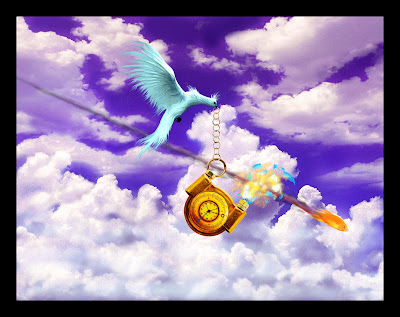
Thus we reach the final iteration of the three part series. I had a hard time coming up with the concept. I wanted something distinctly different from the other two, maybe something abstract but still somewhat familiar - I decided on "other-worldly". And whats more other-worldly then a fish flying through the air like a bullet?
My first step, using the very first image as the base of course, was to change up the dove a bit. I did this with my trusty Smudge Tool as you may have guessed. After that, I took the lightbulb apart in chunks and made it's explosion. Then came the goldfish and it's smoke trail. It took a combination of painting then selections and a motion blur. Fairly straightforward.
After I had the elements in place, I made the color adjustments. Purple for the sky, greenish/blue for the dove (if you could call it a dove anymore), and I richened the Clockstop to a happy gold.
In the end I ended up really enjoying this project series.



